Decoupling Analysis between Socio-Economic Growth and Air Pollution in Key Regions of China
Abstract
:1. Introduction
2. Materials and Methods
2.1. Study Areas
2.2. Data Sources
2.3. The Social-Economic Growth Index
2.3.1. The Evaluation Index System
2.3.2. Calculation Method of Social-Economic Growth Index
2.4. Tapio Decoupling
2.5. Pearson’s Correlation Analysis
3. Results
3.1. The Spatiotemporal Evolution Characteristics of Air Pollution
3.1.1. Temporal Evolution Characteristics
3.1.2. Spatial Evolution Characteristics
3.2. Decoupling of AQI from Socio-Economic Growth
3.2.1. Decoupling of AQI from Socio-Economic Growth in the BTHSR
3.2.2. Decoupling of AQI from Socio-Economic Growth in the YRDR
3.2.3. Decoupling of AQI from Socio-Economic Growth in FWP
3.2.4. Decoupling of AQI from Socio-Economic Growth in the CCR
3.2.5. Decoupling of AQI from Socio-Economic Growth in the MLRYR
3.2.6. Decoupling of AQI from Socio-Economic Growth in the PRDR
3.2.7. Decoupling of AQI from Socio-Economic Growth in the OPCCSP
3.3. Decoupling of PM2.5 from Socio-Economic Growth
3.3.1. Decoupling of PM2.5 from Socio-Economic Growth in the BTHSR
3.3.2. Decoupling of PM2.5 from Socio-Economic Growth in the YRDR
3.3.3. Decoupling of PM2.5 from Socio-Economic Growth in the FWP
3.3.4. Decoupling of PM2.5 from Socio-Economic Growth in the CCR
3.3.5. Decoupling of PM2.5 from Socio-Economic Growth in the MLRYR
3.3.6. Decoupling of PM2.5 from Socio-Economic Growth in the PRDR
3.3.7. Decoupling of PM2.5 from Socio-Economic Growth in the OPCCSP
3.4. Decoupling Analysis
4. Discussion
5. Conclusions and Policies
5.1. Conclusions
- (1)
- Although continuous improvement in air quality was observed in the seven key regions in China, the PM2.5 concentrations were still higher than the health standard values of the World Health Organization (5 μg·m−3), with annual contents of 19.37–46.64 μg·m−3. More worthy of attention is that PM2.5 concentration was still higher than 35 μg·m−3 in Beijing–Tianjin–Hebei and its surrounding areas and the Fen-Wei Plain. The AQI showed a spatial pattern of higher in the north and lower in the south, and the distribution of PM2.5 was characterized by higher in the east and lower in the west. Both the intensity and spatial extent of pollution were significantly reduced. However, the decrease in PM2.5 concentration is still a heavy burden.
- (2)
- The decoupling relationship differed between the seven regions. The degree of decoupling between air pollution and socio-economic growth was relatively high in the Pearl River Delta and Yangtze River Delta regions. In contrast, the degree of decoupling was poor in the Fen-Wei Plain and other provincial capitals and municipalities with specialized plan regions. The decoupling states were primarily influenced by industrial structure, energy consumption, and urbanization.
- (3)
- Overall, the decoupling of air pollution from socio-economic growth in the seven key regions was in a strong decoupling state for most of the research period, achieving a relatively ideal decoupling state in 2018. However, the overall decoupling states of the seven regions were not sustainable, and the decoupling stability was relatively poor. The relationship between air pollution and socio-economic growth during the research period changed and did not reach a stable state. China must intensify its efforts in air pollution prevention and control to reduce the PM2.5 concentration and the AQI index, and achieve sustainable development.
5.2. Policies and Limitations
Author Contributions
Funding
Institutional Review Board Statement
Informed Consent Statement
Data Availability Statement
Conflicts of Interest
References
- Li, G.; Fang, C.; Wang, S.; Sun, S. The effect of economic growth, urbanization, and industrialization on fine particulate matter (PM2.5) concentrations in china. Environ. Sci. Technol. 2016, 50, 11452–11459. [Google Scholar] [CrossRef] [PubMed]
- Ministry of Ecology and Environmentthe People’s Republic of China. Report on the State of the Environment in China 2014. Available online: http://english.mee.gov.cn/Resources/Reports/ (accessed on 31 July 2024).
- Shaddick, G.; Thomas, M.L.; Mudu, P.; Ruggeri, G.; Gumy, S. Half the world’s population are exposed to increasing air pollution. NPJ Clim. Atmos. Sci. 2020, 3, 23. [Google Scholar] [CrossRef]
- Sierra-Vargas, M.P.; Teran, L.M. Air pollution: Impact and prevention. Respirology 2012, 17, 1031–1038. [Google Scholar] [CrossRef]
- Feng, J.; Cavallero, S.; Hsiai, T.; Li, R. Impact of air pollution on intestinal redox lipidome and microbiome. Free Radic. Biol. Med. 2020, 151, 99–110. [Google Scholar] [CrossRef]
- Buoli, M.; Grassi, S.; Caldiroli, A.; Carnevali, G.S.; Mucci, F.; Iodice, S.; Cantone, L.; Pergoli, L.; Bollati, V. Is there a link between air pollution and mental disorders? Environ. Int. 2018, 118, 154–168. [Google Scholar] [CrossRef]
- Fajersztajn, L.; Veras, M.; Barrozo, L.V.; Saldiva, P. Air pollution: A potentially modifiable risk factor for lung cancer. Nat. Rev. Cancer 2013, 13, 674–678. [Google Scholar] [CrossRef]
- Ambrey, C.L.; Fleming, C.M.; Chan, A.Y.-C. Estimating the cost of air pollution in south east queensland: An application of the life satisfaction non-market valuation approach. Ecol. Econ. 2014, 97, 172–181. [Google Scholar] [CrossRef]
- Yuan, L.; Shin, K.; Managi, S. Subjective well-being and environmental quality: The impact of air pollution and green coverage in china. Ecol. Econ. 2018, 153, 124–138. [Google Scholar] [CrossRef]
- Shao, M.; Wang, W.; Yuan, B.; Parrish, D.D.; Li, X.; Lu, K.; Wu, L.; Wang, X.; Mo, Z.; Yang, S.; et al. Quantifying the role of PM2.5 dropping in variations of ground-level ozone: Inter-comparison between beijing and los angeles. Sci. Total Environ. 2021, 788, 147712. [Google Scholar] [CrossRef]
- Furie, G.L.; Balbus, J. Global environmental health and sustainable development: The role at rio+20. Cien Saude Colet. 2012, 17, 1427–1432. [Google Scholar] [CrossRef]
- Balwinder, S.; McDonald, A.J.; Srivastava, A.K.; Gerard, B. Tradeoffs between groundwater conservation and air pollution from agricultural fires in northwest india (vol 2, pg 580, 2019). Nat. Sustain. 2020, 3, 972. [Google Scholar] [CrossRef]
- Fenech, S.; Doherty, R.M.; O’connor, F.M.; Heaviside, C.; Macintyre, H.L.; Vardoulakis, S.; Agnew, P.; Neal, L.S. Future air pollution related health burdens associated with rcp emission changes in the uk. Sci. Total Environ. 2021, 773, 145635. [Google Scholar] [CrossRef] [PubMed]
- Burnett, R.; Chen, H.; Szyszkowicz, M.; Fann, N.; Hubbell, B.; Pope, C.A.; Apte, J.S.; Brauer, M.; Cohen, A.; Weichenthal, S.; et al. Global estimates of mortality associated with long-term exposure to outdoor fine particulate matter. Proc. Natl. Acad. Sci. USA 2018, 115, 9592–9597. [Google Scholar] [CrossRef]
- Ali, S.H.; Puppim de Oliveira, J.A. Pollution and economic development: An empirical research review. Environ. Res. Lett. 2018, 13, 123003. [Google Scholar] [CrossRef]
- Xie, Q.; Xu, X.; Liu, X. Is there an ekc between economic growth and smog pollution in china? New evidence from semiparametric spatial autoregressive models. J. Clean. Prod. 2019, 220, 873–883. [Google Scholar] [CrossRef]
- Li, Z.; Song, Y.; Zhou, A.; Liu, J.; Pang, J.; Zhang, M. Study on the pollution emission efficiency of china’s provincial regions: The perspective of environmental kuznets curve. J. Clean. Prod. 2020, 263, 121497. [Google Scholar] [CrossRef]
- Jiang, S.; Tan, X.; Hu, P.; Wang, Y.; Shi, L.; Ma, Z.; Lu, G. Air pollution and economic growth under local government competition: Evidence from china, 2007–2016. J. Clean. Prod. 2022, 334, 130231. [Google Scholar] [CrossRef]
- Wang, L.; Wang, H.; Dong, Z.; Wang, S.; Cao, Z. The air pollution effect of government economic growth expectations: Evidence from china’s cities based on green technology. Environ. Sci. Pollut. Res. 2021, 28, 27639–27654. [Google Scholar] [CrossRef]
- OECD. Indicators to Measure Decoupling of Environmental Pressure from Economic Growth. 2002. Available online: https://one.oecd.org/document/SG/SD(2002)1/FINAL/en/pdf (accessed on 10 September 2023).
- Juknys, R. Transition period in lithuania-do we move to sustainability. Energy 2003, 4, 4–9. [Google Scholar]
- Tapio, P. Towards a theory of decoupling: Degrees of decoupling in the eu and the case of road traffic in finland between 1970 and 2001. Transp. Policy 2005, 12, 137–151. [Google Scholar] [CrossRef]
- Conrad, E.; Cassar, L.F. Decoupling economic growth and environmental degradation: Reviewing progress to date in the small island state of malta. Sustainability 2014, 6, 6729–6750. [Google Scholar] [CrossRef]
- Sanye-Mengual, E.; Secchi, M.; Corrado, S.; Beylot, A.; Sala, S. Assessing the decoupling of economic growth from environmental impacts in the european union: A consumption-based approach. J. Clean. Prod. 2019, 236, 117535. [Google Scholar] [CrossRef]
- Luo, H.; Li, L.; Lei, Y.; Wu, S.; Yan, D.; Fu, X.; Luo, X.; Wu, L. Decoupling analysis between economic growth and resources environment in central plains urban agglomeration. Sci. Total Environ. 2021, 752, 142284. [Google Scholar] [CrossRef]
- Zhou, X.; Zhang, M.; Zhou, M.; Zhou, M. A comparative study on decoupling relationship and influence factors between china’s regional economic development and industrial energy-related carbon emissions. J. Clean. Prod. 2017, 142, 783–800. [Google Scholar] [CrossRef]
- Zhang, X.; Geng, Y.; Shao, S.; Song, X.; Fan, M.; Yang, L.; Song, J. Decoupling PM2.5 emissions and economic growth in china over 1998–2016: A regional investment perspective. Sci Total Environ. 2020, 714, 136841. [Google Scholar] [CrossRef] [PubMed]
- Raza, M.Y.; Lin, B. Decoupling and mitigation potential analysis of CO2 emissions from pakistan’s transport sector. Sci. Total Environ. 2020, 730, 139000. [Google Scholar] [CrossRef]
- Oliveira, R.P.; Oliveira, A.V.M.; Lohmann, G.; Bettini, H. The geographic concentrations of air traffic and economic development: A spatiotemporal analysis of their association and decoupling in brazil. J. Transp. Geogr. 2020, 87, 102792. [Google Scholar] [CrossRef] [PubMed]
- de Freitas, L.C.; Kaneko, S. Decomposing the decoupling of CO2 emissions and economic growth in brazil. Ecol. Econ. 2011, 70, 1459–1469. [Google Scholar] [CrossRef]
- Zhang, Z.; Hu, B.; Shi, K.; Su, K.; Yang, Q. Exploring the dynamic, forecast and decoupling effect of land natural capital utilization in the hinterland of the three gorges reservoir area, china. Sci. Total Environ. 2020, 718, 134832. [Google Scholar] [CrossRef]
- Li, Y.-N.; Cai, M.; Wu, K.; Wei, J. Decoupling analysis of carbon emission from construction land in shanghai. J. Clean. Prod. 2019, 210, 25–34. [Google Scholar] [CrossRef]
- Wei, Z.Q.; Wei, K.K.; Liu, J.C.; Zhou, Y.Z. The relationship between agricultural and animal husbandry economic development and carbon emissions in henan province, the analysis of factors affecting carbon emissions, and carbon emissions prediction. Mar. Pollut. Bull. 2023, 193, 115134. [Google Scholar] [CrossRef]
- Hu, J.X.; Chi, L.; Xing, L.W.; Meng, H.; Zhu, M.S.; Zhang, J.; Wu, J.Z. Decomposing the decoupling relationship between energy consumption and economic growth in china’s agricultural sector. Sci. Total Environ. 2023, 873, 162323. [Google Scholar] [CrossRef] [PubMed]
- Engo, J. Decomposing the decoupling of CO2 emissions from economic growth in cameroon. Environ. Sci. Pollut. Res. 2018, 25, 35451–35463. [Google Scholar] [CrossRef] [PubMed]
- Roinioti, A.; Koroneos, C. The decomposition of CO2 emissions from energy use in greece before and during the economic crisis and their decoupling from economic growth. Renew. Sustain. Energy Rev. 2017, 76, 448–459. [Google Scholar] [CrossRef]
- Liang, S.; Liu, Z.; Crawford-Brown, D.; Wang, Y.F.; Xu, M. Decoupling analysis and socioeconomic drivers of environmental pressure in china. Environ. Sci. Technol. 2014, 48, 1103–1113. [Google Scholar] [CrossRef] [PubMed]
- Yuan, L.; Li, R.; Wu, X.; He, W.; Kong, Y.; Ramsey, T.S.; Degefu, D.M. Decoupling of economic growth and resources-environmental pressure in the yangtze river economic belt, china. Ecol. Indic. 2023, 153, 110399. [Google Scholar] [CrossRef]
- Zhang, Y.Y.; Sun, M.Y.; Yang, R.J.; Li, X.H.; Zhang, L.; Li, M.Y. Decoupling water environment pressures from economic growth in the yangtze river economic belt, china. Ecol. Indic. 2021, 122, 107314. [Google Scholar] [CrossRef]
- Wang, X.; Lu, C.; Cao, Y.; Chen, L.; Abedin, M.Z. Decomposition, decoupling, and future trends of environmental effects in the beijing-tianjin-hebei region: A regional heterogeneity-based analysis. J. Environ. Manag. 2023, 331, 117124. [Google Scholar] [CrossRef]
- Dong, J.; Li, C. Scenario prediction and decoupling analysis of carbon emission in jiangsu province, china. Technol. Forecast. Soc. Change 2022, 185, 122074. [Google Scholar] [CrossRef]
- Ji, S.; Lv, W.; Meng, L.; Yang, X.; Yang, H.; Chuan, Y.; Chen, H.; Hayat, T.; Alsaedi, A.; Ahmad, B. Decoupling environmental pressures from economic growth based on emissions monetization: Case in yunnan, china. J. Clean. Prod. 2019, 208, 1563–1576. [Google Scholar] [CrossRef]
- Yu, Y.; Zhou, L.; Zhou, W.; Ren, H.; Kharrazi, A.; Ma, T.; Zhu, B. Decoupling environmental pressure from economic growth on city level: The case study of chongqing in china. Ecol. Indic. 2017, 75, 27–35. [Google Scholar] [CrossRef]
- Chang, M.; Zheng, J.; Inoue, Y.; Tian, X.; Chen, Q.; Gan, T. Comparative analysis on the socioeconomic drivers of industrial air-pollutant emissions between japan and china: Insights for the further-abatement period based on the lmdi method. J. Clean. Prod. 2018, 189, 240–250. [Google Scholar] [CrossRef]
- Bichler, R.; Schönebeck, S.S.; Bittner, M. Observing decoupling processes of NO2 pollution and gdp growth based on satellite observations for los angeles and tokyo. Atmos. Environ. 2023, 310, 119968. [Google Scholar] [CrossRef]
- Ministry of Ecology and Environmentthe People’s Republic of China. Report on the State of the Ecology and Environment in China 2022. Available online: http://english.mee.gov.cn/Resources/Reports/ (accessed on 18 December 2023).
- Zhang, Z.; Chen, X.; Heck, P.; Xue, B.; Liu, Y. Empirical study on the environmental pressure versus economic growth in china during 1991–2012. Resour. Conserv. Recycl. 2015, 101, 182–193. [Google Scholar] [CrossRef]
- Yu, Y.; Chen, D.; Zhu, B.; Hu, S. Eco-efficiency trends in china, 1978-2010: Decoupling environmental pressure from economic growth. Ecol. Indic. 2013, 24, 177–184. [Google Scholar] [CrossRef]
- Ministry of Ecology and Environment of the People’s Republic of China. January 2019 National Urban Air Quality Report. Available online: https://www.mee.gov.cn/hjzl/dqhj/cskqzlzkyb/index_4.shtml (accessed on 1 August 2023).
- Qin, X.; Hu, X.; Xia, W. Investigating the dynamic decoupling relationship between regional social economy and lake water environment: The application of dpsir-extended tapio decoupling model. J. Environ. Manag. 2023, 345, 118926. [Google Scholar] [CrossRef] [PubMed]
- Fan, Y.; Fang, C.; Zhang, Q. Coupling coordinated development between social economy and ecological environment in chinese provincial capital cities-assessment and policy implications. J. Clean. Prod. 2019, 229, 289–298. [Google Scholar] [CrossRef]
- Zhang, K.; Jin, Y.; Li, D.; Wang, S.; Liu, W. Spatiotemporal variation and evolutionary analysis of the coupling coordination between urban social-economic development and ecological environments in the yangtze river delta cities. Sustain. Cities Soc. 2024, 105561. [Google Scholar] [CrossRef]
- HJ 663—2013; Technical Regulation for Ambient Air Quality Assessment (on Trial). Ministry of Ecology and Environment of the People’s Republic of China: Beijing, China, 2013.
- Zhang, Z.; Wang, W.; Cheng, M.; Liu, S.; Xu, J.; He, Y.; Meng, F. The contribution of residential coal combustion to PM2.5 pollution over china’s beijing-tianjin-hebei region in winter. Atmos. Environ. 2017, 159, 147–161. [Google Scholar] [CrossRef]
- Li, J.; Ren, L.; Wu, Y.; Zhang, R.; Yang, X.; Li, G.; Gao, E.; An, J.; Xu, Y. Different variations in PM2.5 sources and their specific health risks in different periods in a heavily polluted area of the beijing-tianjin-hebei region of china. Atmos. Res. 2024, 308, 107519. [Google Scholar] [CrossRef]
- Wu, J.; Zhan, X.; Xu, H.; Ma, C. The economic impacts of covid-19 and city lockdown: Early evidence from china. Struct. Change Econ. Dyn. 2023, 65, 151–165. [Google Scholar] [CrossRef]
- Chinese Academy of Enviromental Planing. Research Report on Total Coal Control in Fenwei Plain: Deepening the Battle of Pollution Prevention and Control. Available online: http://www.nrdc.cn/Public/uploads/2023-07-11/64acba9b171ee.pdf (accessed on 18 May 2024).
- Lin, C.; Huang, R.-J.; Zhong, H.; Duan, J.; Wang, Z.; Huang, W.; Xu, W. Elucidating ozone and PM2.5 pollution in the fenwei plain reveals theco-benefits of controlling precursor gas emissions in winter haze. Atmos. Chem. Phys. 2023, 23, 3595–3607. [Google Scholar] [CrossRef]
- Cao, J.J.; Cui, L. Current status, characteristics and causes of particulate air pollution in the fenwei plain, china: A review. J. Geophys. Res. -Atmos. 2021, 126, e2020JD034472. [Google Scholar] [CrossRef]
- Chen, B.; Wang, X.B.; Li, Y.L.; Yang, Q.; Li, J.S. Energy-induced mercury emissions in global supply chain networks: Structural characteristics and policy implications. Sci. Total Environ. 2019, 670, 87–97. [Google Scholar] [CrossRef] [PubMed]
- Xiao, C.; Zhou, J.; Meng, F.; Cullen, J.; Wang, X.; Zhu, Y. Regional characteristics and spatial correlation of haze pollution: Interpretative system analysis in cities of fenwei plain in china. Sci. Total Environ. 2023, 869, 161779. [Google Scholar] [CrossRef] [PubMed]
- Tian, M.; Wang, H.; Chen, Y.; Zhang, L.; Shi, G.; Liu, Y.; Yu, J.; Zhai, C.; Wang, J.; Yang, F. Highly time-resolved characterization of water-soluble inorganic ions in PM2.5 in a humid and acidic mega city in sichuan basin, china. Sci. Total Environ. 2017, 580, 224–234. [Google Scholar] [CrossRef]
- Liu, B. An analysis of energy efficiency of the pearl river delta of china based on super-efficiency sbm model and malmquist index. Environ. Sci. Pollut. Res. 2023, 30, 18998–19011. [Google Scholar] [CrossRef]
- Liang, L.; Gong, P. Urban and air pollution: A multi-city study of long-term effects of urban landscape patterns on air quality trends. Sci. Rep. 2020, 10, 18618. [Google Scholar] [CrossRef]
- Wu, W.; Zhao, K. Does upgrading of industrial structure drive economy to “decouple” from environment: An empirical analysis based on the data of prefecture-level cities in china. J. Knowl. Econ. 2023, 14, 287–313. [Google Scholar] [CrossRef]
- Yuan, Y.; Lu, Y.; Xie, J.; Tao, J.; Chuai, X.; Huang, S.; Zhang, R.; Zhai, J.; Wang, X.; Pu, L. Decoupling and decomposition analysis of industrial carbon emissions and economic growth in china from a dynamic perspective. Environ. Dev. Sustain. 2024. [Google Scholar] [CrossRef]
- Zhao, Y.; Li, F.; Yang, Y.; Zhang, Y.; Dai, R.; Li, J.; Wang, M.; Li, Z. Driving forces and relationship between air pollution and economic growth based on ekc hypothesis and stirpat model: Evidence from henan province, china. Air Qual. Atmos. Health 2023, 16, 1891–1906. [Google Scholar] [CrossRef] [PubMed]
- Zhu, Y.; Wang, Z.; Yang, J.; Zhu, L. Does renewable energy technological innovation control china’s air pollution? A spatial analysis. J. Clean. Prod. 2020, 250, 119515. [Google Scholar] [CrossRef]
- Lei, H.; Xu, W. How does the transformation of the energy structure impact the coordinated development of economy and environment? Environ. Sci. Pollut. Res. 2023, 30, 112368–112384. [Google Scholar] [CrossRef] [PubMed]
- Zhu, M.; Guo, J.; Zhou, Y.; Cheng, X. Exploring the spatiotemporal evolution and socioeconomic determinants of PM2.5 distribution and its hierarchical management policies in 366 chinese cities. Front. Public. Health 2022, 10, 843862. [Google Scholar] [CrossRef]
- Fei-fei, Z.; Zheng, H.; Xu, Z.; Wei-jun, H. Identification and solution of decoupling trap between carbon emissions and economic growth in yangtze river economic belt. Res. Environ. Yangtze Basin 2023, 32, 1127–1137. [Google Scholar] [CrossRef]
- ZhenFeng, Z.; YuKun, C. Pseudo decoupling risk of economic growth and resource consumption identifying and cracking in the national forestry area. Sci. Silvae Sin. 2017, 53, 139–149. [Google Scholar] [CrossRef]
- Khan, R. Catch-up growth with alpha and beta decoupling and their relationships between CO2 emissions by gdp, population, energy production, and consumption. Heliyon 2024, 10, e31470. [Google Scholar] [CrossRef]
- Magazzino, C.; Mele, M.; Sarkodie, S.A. The nexus between covid-19 deaths, air pollution and economic growth in new york state: Evidence from deep machine learning. J. Environ. Manage. 2021, 286, 112241. [Google Scholar] [CrossRef]

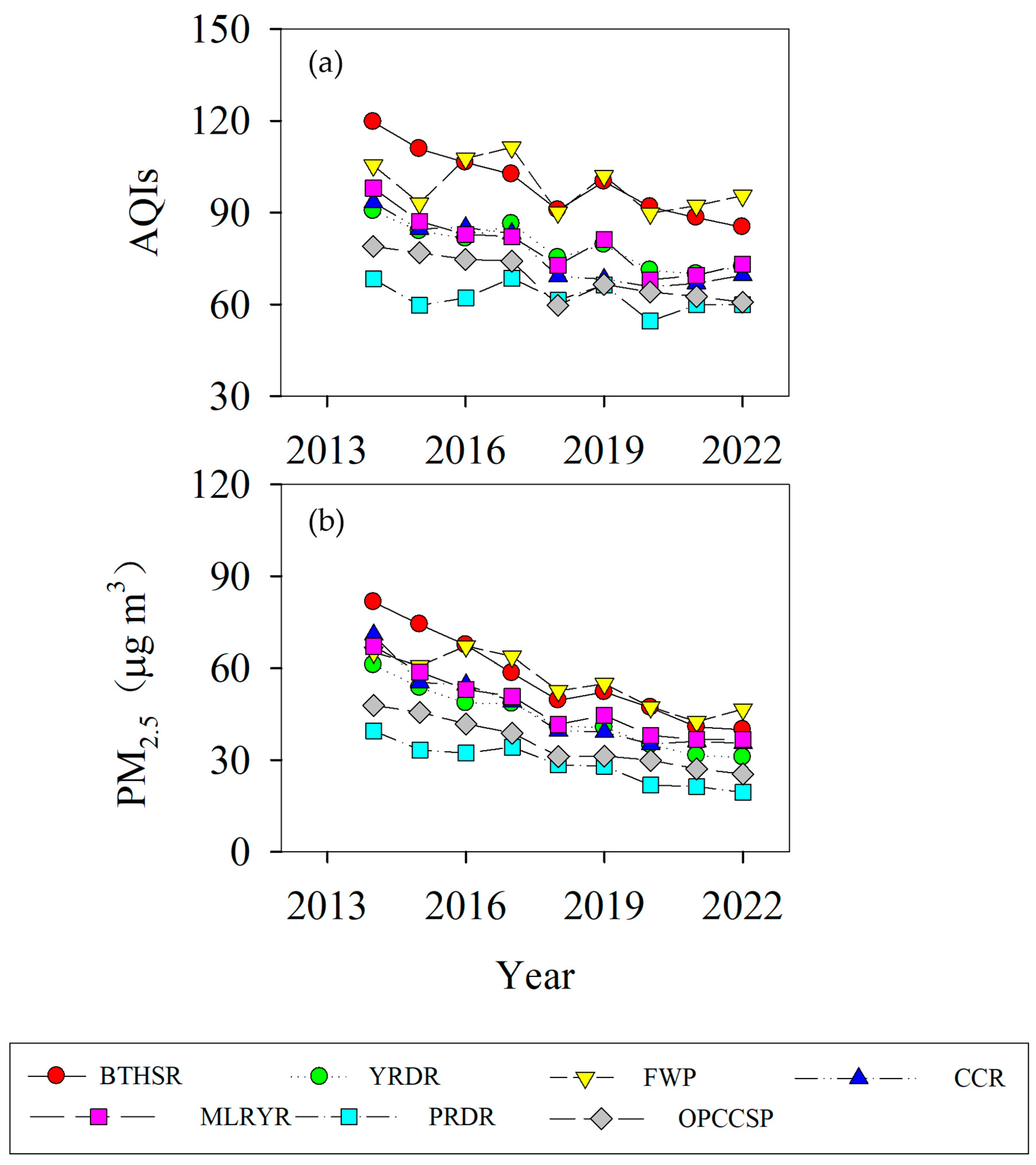
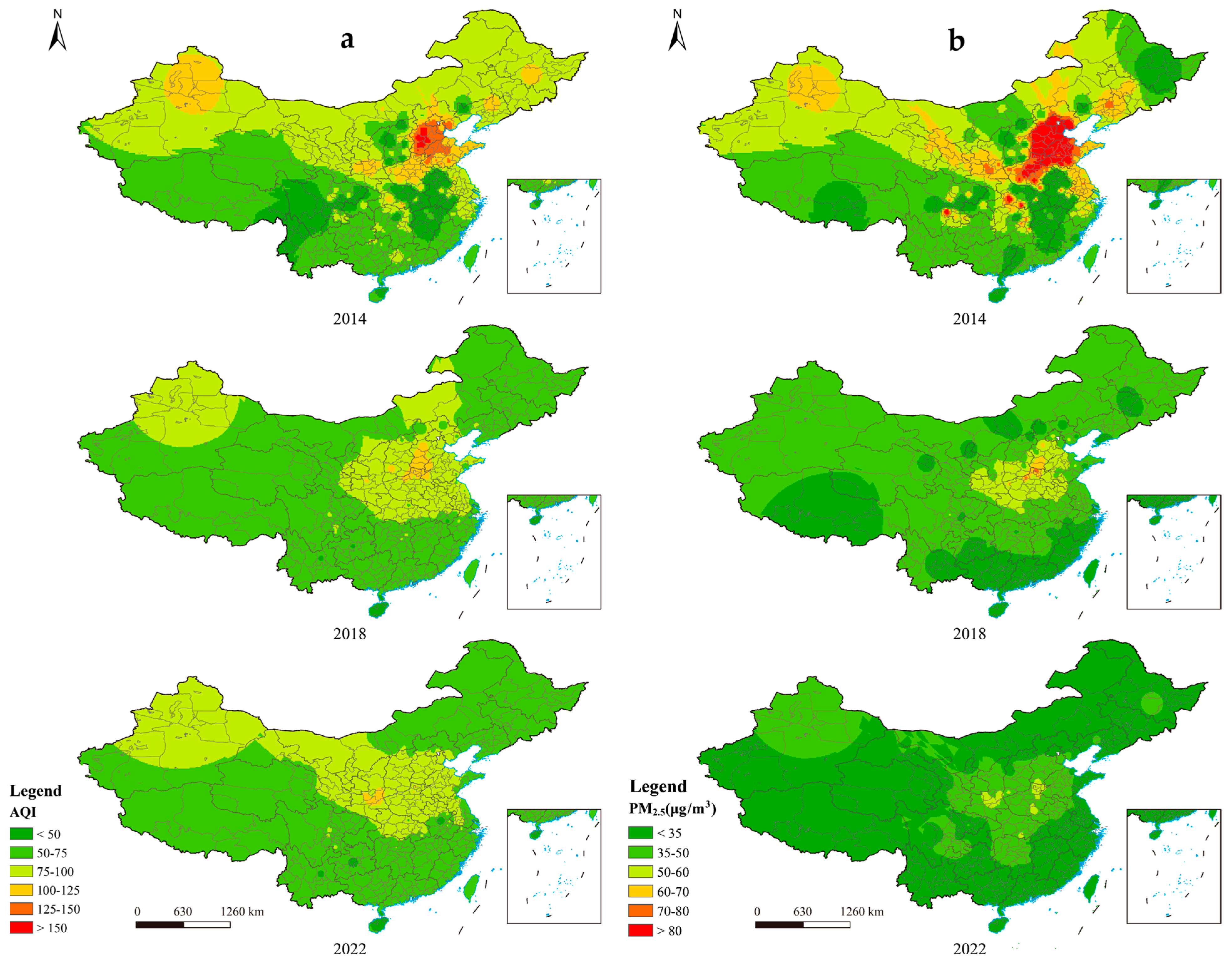
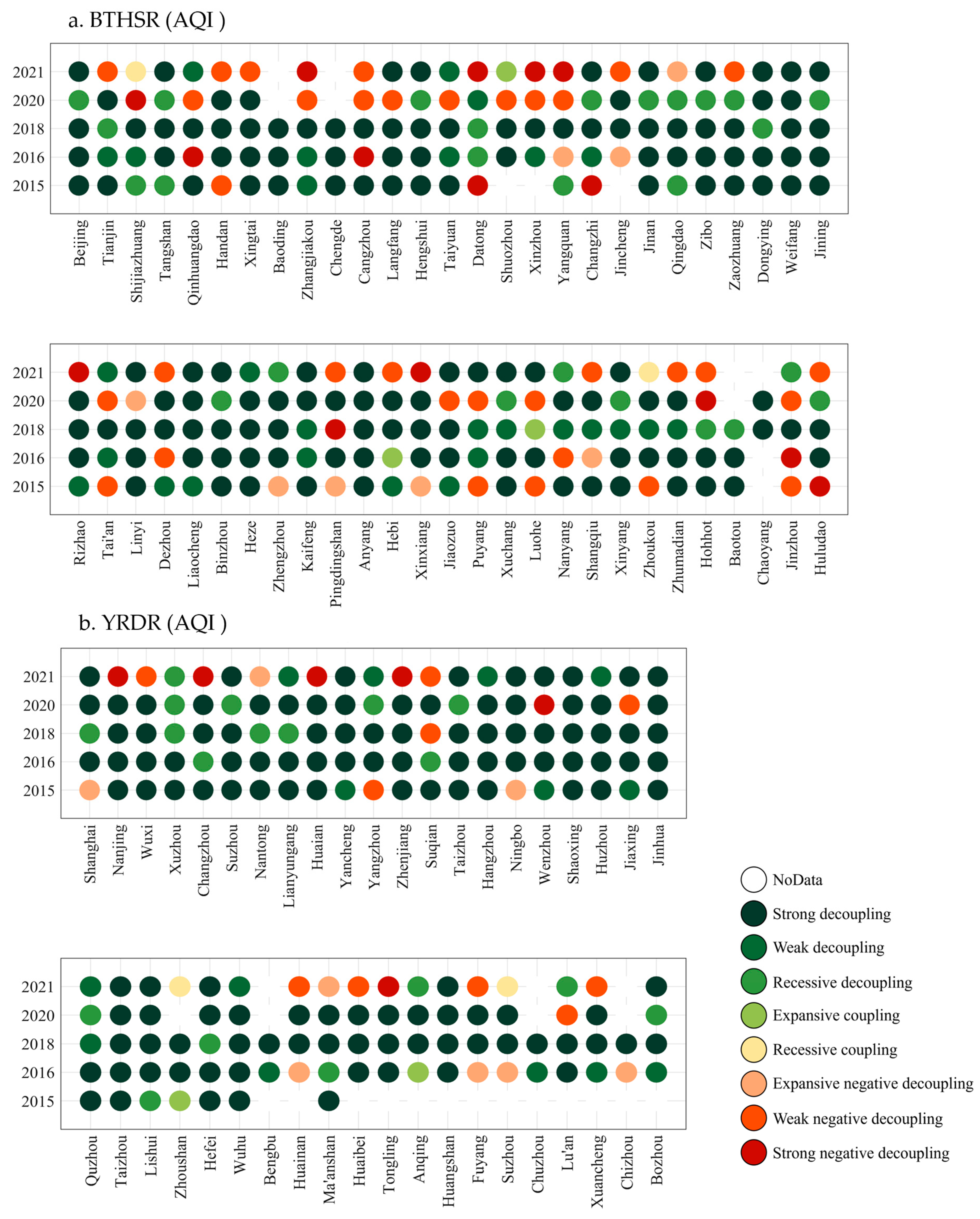
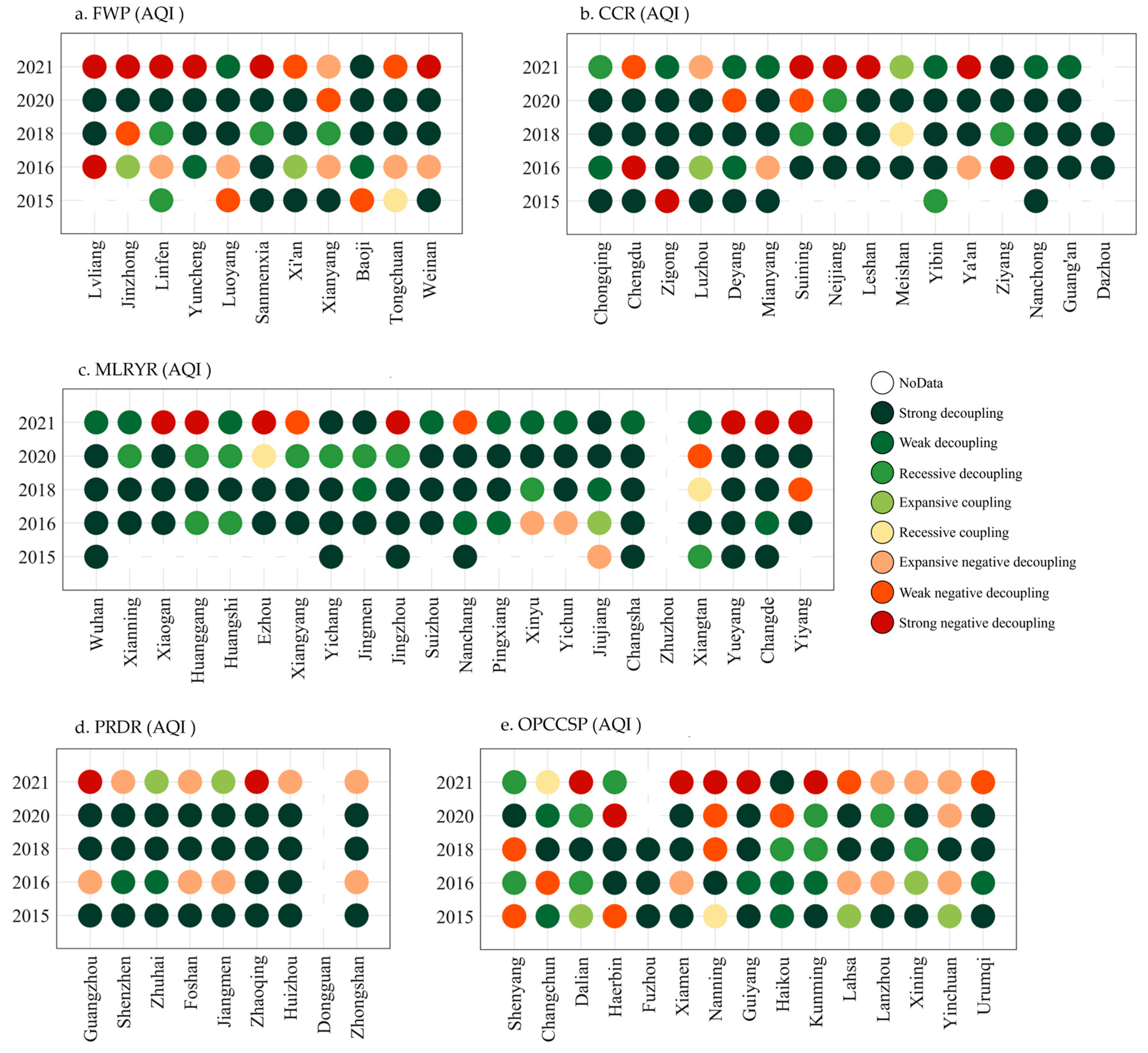
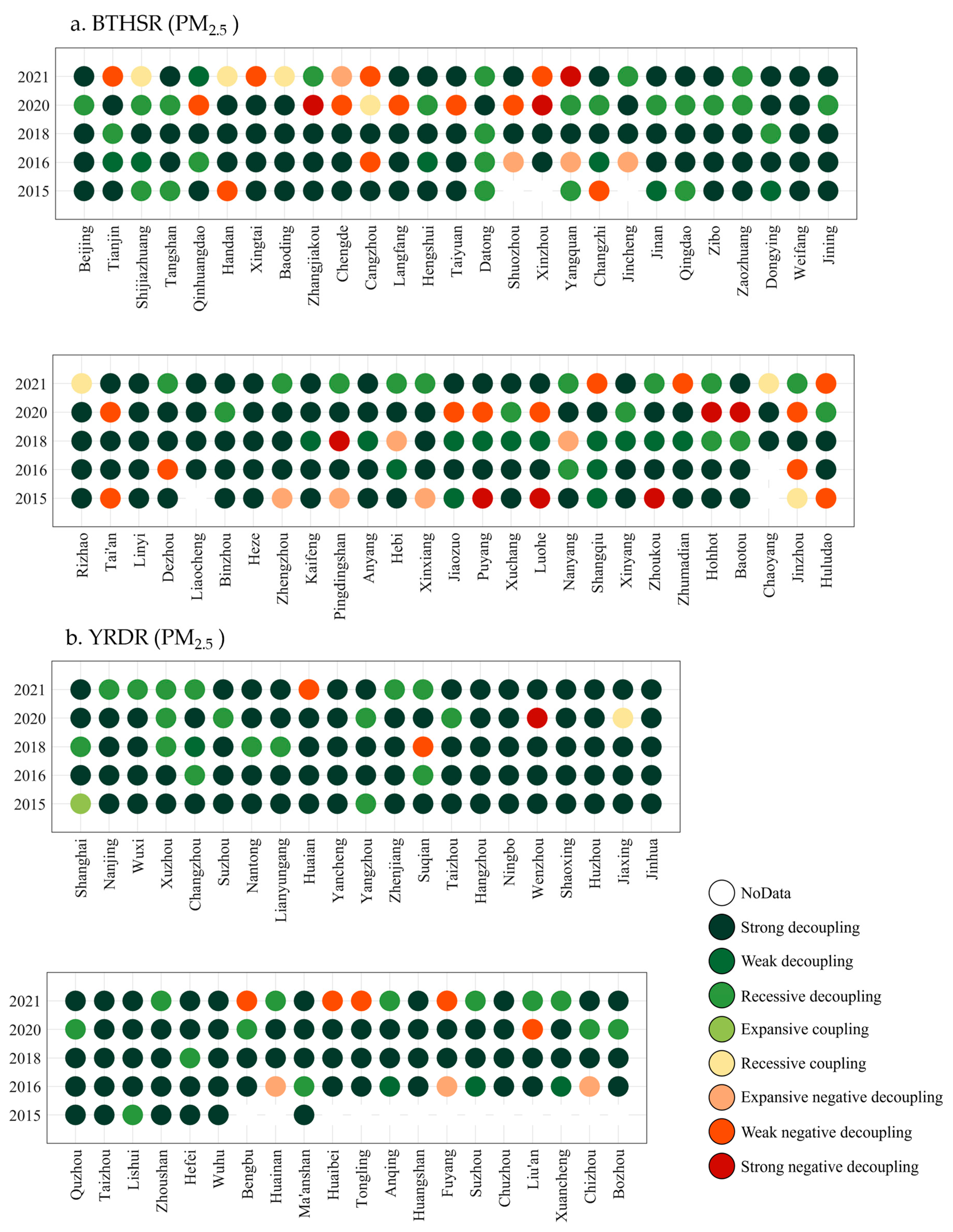

| Modules | Sub-Indices | Units | Data Sources |
|---|---|---|---|
| Urban Development and Population Growth (UDPG) | Population (UD1) | 10,000 people | Statistical yearbook of each city |
| Urbanization (UD2) | % | ||
| GDP (UD3-EG1) | CNY 100 million | ||
| Per Capita GDP (UD4) | |||
| Vehicle Population (UD5) | unit | ||
| Economic Growth and Changes in Industrial Structure (EGCIS) | GDP (UD3-EG1) | CNY 100 million | Statistical yearbook of each city |
| Added Value of Primary Industry (EG2) | CNY 100 million | ||
| Added Value of Secondary Industry (EG3) | CNY 100 million | ||
| Added Value of Tertiary Industry (EG4) | CNY 100 million | ||
| Industry Output Value (EG5) | CNY 100 million | ||
| Construction Output Value (EG6) | CNY 100 million | ||
| Tourism revenue (EG7) | CNY 100 million | ||
| Percentage of GDP of the Added Value of Primary Industry (EG8) | % | ||
| Percentage of GDP of the Added Value of Secondary Industry (EG9) | % | ||
| Percentage of GDP of the Added Value of Tertiary Industry (EG10) | % | ||
| Energy Consumption Growth and Structure Change (ECGSC) | Living Energy Consumption (ES1) | 10,000 tons of SCE (standard coal equivalent) | Compute |
| Energy Consumption of Large-Scale Enterprises (ES2) | 10,000 tons of SCE (standard coal equivalent) | Statistical yearbook of each city | |
| Raw Coal Consumption of Large-Scale Enterprises (ES3) | ton | ||
| Power Consumption of Large-Scale Enterprises (ES4) | Billion kW-h | ||
| Thermal Consumption of Large-Scale Enterprises (ES5) | 1 million kilo-joule |
| Decoupling State | ΔPI | ∆SEGI | DI | Meaning | |
|---|---|---|---|---|---|
| Decoupling | Strong decoupling (SD) | <0 | >0 | DI < 0 | Best: SEGI increases and PI decreases |
| Weak decoupling (WD) | >0 | >0 | 0 < DI < 0.8 | Better: SEGI increases rate more than PI increases rate | |
| Recessive decoupling (RD) | <0 | <0 | DI > 1.2 | Good: PI declines rate more than SEGI declines rate | |
| Coupling | Expansive coupling (EC) | >0 | >0 | 0.8 < DI < 1.2 | Worse: SEGI increases and PI increases |
| Recessive coupling (RC) | <0 | <0 | 0.8 < DI < 1.2 | Average: SEGI decreases and PI decreases | |
| Negative Decoupling | Expansive negative decoupling (END) | >0 | >0 | DI > 1.2 | Poor: PI increases rate more than SEGI increases rate |
| Weak negative decoupling (WND) | <0 | <0 | 0 < DI < 0.8 | Very Bad: SEGI decreases rate more than PI decreases rate | |
| Strong negative decoupling (SND) | >0 | <0 | DI < 0 | Worst: SEGI decreases and PI increases | |
| The Proportion of Cities with Strong Decoupling (%) | BTHSR | YRDR | FWP | CCR | MLRYR | PRDR | OPCCSP |
|---|---|---|---|---|---|---|---|
| PM2.5, SEGI | 57.96 | 75.52 | 49.1 | 61.6 | 60.6 | 85.37 | 45.21 |
| AQI, SEGI | 55.04 | 67.57 | 44.23 | 58.57 | 54.84 | 65.00 | 36.99 |
| UD1 | UD2 | UD3-EG1 | UD4 | UD5 | EG2 | EG3 | EG4 | EG5 | EG6 | EG7 | EG8 | EG9 | EG10 | ES1 | ES2 | ES3 | ES4 | ES5 | |
|---|---|---|---|---|---|---|---|---|---|---|---|---|---|---|---|---|---|---|---|
| R | 0.084 | 0.343 | 0.019 | −0.244 | −0.013 | 0.062 | 0.012 | −0.105 | 0.121 | −0.016 | −0.108 | 0.114 | 0.378 | −0.136 | −0.028 | 0.290 | 0.034 | −0.010 | 0.073 |
| P | 0.003 | 0.000 | 0.500 | 0.000 | 0.678 | 0.029 | 0.684 | 0.010 | 0.000 | 0.604 | 0.001 | 0.001 | 0.000 | 0.000 | 0.356 | 0.000 | 0.315 | 0.754 | 0.020 |
| UD1 | UD2 | UD3-EG1 | UD4 | UD5 | EG2 | EG3 | EG4 | EG5 | EG6 | EG7 | EG8 | EG9 | EG10 | ES1 | ES2 | ES3 | ES4 | ES5 | |
|---|---|---|---|---|---|---|---|---|---|---|---|---|---|---|---|---|---|---|---|
| R | 0.080 | 0.193 | 0.109 | 0.055 | 0.092 | 0.0785 | 0.314 | 0.134 | 0.072 | 0.008 | 0.003 | −0.020 | 0.036 | 0.124 | 0.058 | 0.023 | 0.270 | 0.020 | 0.007 |
| P | 0.026 | 0.000 | 0.004 | 0.078 | 0.024 | 0.032 | 0.000 | 0.000 | 0.069 | 0.800 | 0.922 | 0.569 | 0.236 | 0.001 | 0.072 | 0.530 | 0.000 | 0.569 | 0.845 |
Disclaimer/Publisher’s Note: The statements, opinions and data contained in all publications are solely those of the individual author(s) and contributor(s) and not of MDPI and/or the editor(s). MDPI and/or the editor(s) disclaim responsibility for any injury to people or property resulting from any ideas, methods, instructions or products referred to in the content. |
© 2024 by the authors. Licensee MDPI, Basel, Switzerland. This article is an open access article distributed under the terms and conditions of the Creative Commons Attribution (CC BY) license (https://creativecommons.org/licenses/by/4.0/).
Share and Cite
Wei, M.; Chuai, X.; Li, Y.; Han, J.; Zhang, C. Decoupling Analysis between Socio-Economic Growth and Air Pollution in Key Regions of China. Sustainability 2024, 16, 7571. https://doi.org/10.3390/su16177571
Wei M, Chuai X, Li Y, Han J, Zhang C. Decoupling Analysis between Socio-Economic Growth and Air Pollution in Key Regions of China. Sustainability. 2024; 16(17):7571. https://doi.org/10.3390/su16177571
Chicago/Turabian StyleWei, Manru, Xiaoming Chuai, Yisai Li, Jingwen Han, and Chunxia Zhang. 2024. "Decoupling Analysis between Socio-Economic Growth and Air Pollution in Key Regions of China" Sustainability 16, no. 17: 7571. https://doi.org/10.3390/su16177571




